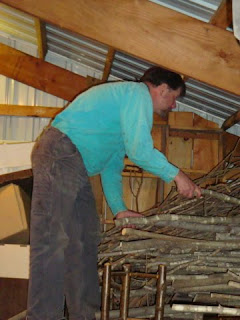
For stretchers (rungs -- usually the tenon or peg part of the joint), I want very dry wood so there's no additional shrinkage after the furniture is made that could loosen a joint. Sticks that get mortises (the hole that the peg fits into) can have a higher moisture content, because when the wood shrinks around a tenon it actually makes the joint tighter. But since some designs I build can have sticks with both mortises and tenons, I generally like to make sure all my wood is good and dry.
As the sticks dry, it's normal to see some checking in the end grain. As I build furniture, these ends get cut off and go into the wood stove.

Before I start building, wood comes out of the piles in the loft and down into my shop where it's handier.

With one thing and another, some of the sticks I harvested this fall haven't made it up into the loft for seasoning yet. The rest are in a pile that was too handy for my wife. She was dyeing fabric this week and with snow too deep to get to the clothesline she grabbed sticks from that pile, shoved them into a snowbank, and draped fabric over them to drip.

I doubt you'll be seeing The Red Collection in my rustic furniture line, but you never know.
Next time I'll tell you about some of the tools I use in rustic furniture construction. In the meantime, here's another use for that pruning saw I use to harvest maple for furniture.

Happy New Year!











